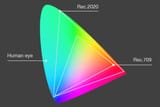>>714050310
Crash course for you:
IPS displays are identical to OLED. It's not like OLED magically has more colors. The main difference between both is the lighting. The amount of lighting affects color quality; too little and whites look washed out, too much and blacks look bright.
OLED monitors use organic diodes that emit light themselves. What this means is that OLED doesn't require a backlight at all, the pixels themselves are the backlight. It's also why you can get true blacks in OLED; to display black, they just shut off the pixel and backlight itself, making it no different than a monitor that's just off. HDR uses the same principle.
With IPS, it's more complicated. They need a backlight to function. A majority of IPS monitors use something called CCFL; there's a giant light bulb behind the monitor that's diffused by a liquid crystal layer. This has a lot of issues; it means that you can't get "true black" or HDR because you can't turn off the backlight on one pixel without turning all them off which also turns off the monitor (like pressing the backlight button on a GBA SP).
MiniLED and MicroLED attempt to solve this. Instead of one big backlight like CCFL, there are several hundreds/thousands/tens of thousands (depending on your monitor) of smaller lights (LEDs) that can be adjusted or turned off independently. Once you get enough of these (counted as "dimming zones") then you completely solve the problem and it functions identically to OLED.






















